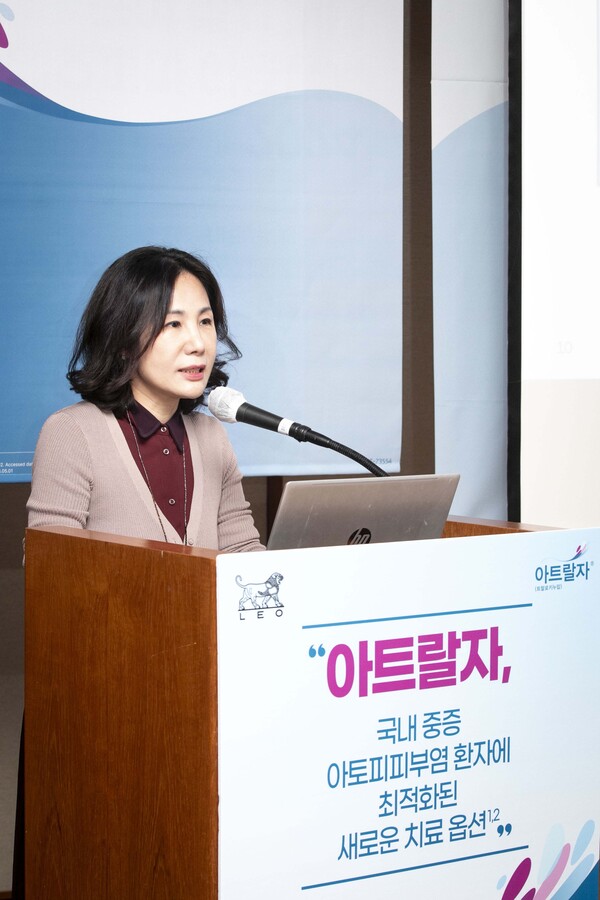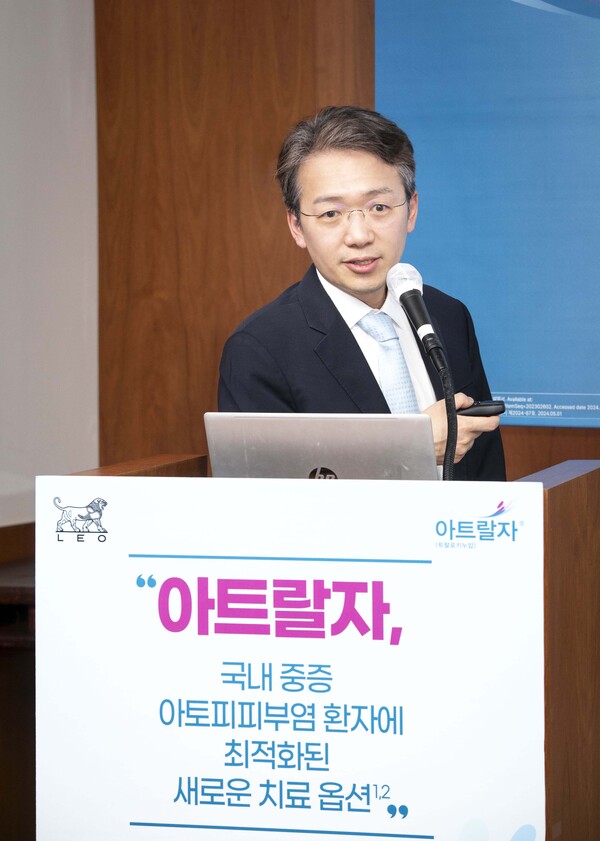LEO Pharma's Adtralza (tralokinumab), covered by health insurance from this month for treating chronic severe atopic dermatitis in adults and adolescents with at least three years of disease, now aims to target the market with convenience and economic feasibility.
Adtralza selectively targets interleukin-13 (IL-13), a key cytokine that triggers the signs and symptoms of atopic dermatitis.
Though it is a biologic like Sanofi's Dupixent (dupilumab), Adtralza is over 30 percent cheaper and can be adjusted to a four-week dosing interval after 16 weeks. This makes it a convenient and cost-effective treatment for atopic dermatitis patients who need long-term treatment.

LEO Pharma held a press conference on Thursday to celebrate the launch of Adtralza with reimbursement and share the unmet need, clinical value, and role of Adtralza in the treatment of atopic dermatitis.
“As of 2022, the number of atopic dermatitis patients in Korea was steadily increasing to 971,000,” said Professor Ahn Ji-young of the Department of Dermatology at the National Medical Center, who explained the unmet needs in the treatment of severe atopic dermatitis at home and abroad. “However, there are still unmet needs, as patients may have different responses to the same treatment, and even if they reach EASI (eczema area and severity index)-75 and want to change drugs due to side effects, they are not allowed to cross-dose.”
Atopic dermatitis is a chronic disease that requires constant management with repeated flare-ups and remissions, Ahn noted, adding that Adtralza is a treatment option with long-term efficacy, a proven safety profile, and improved dosing convenience that Korean physicians and patients highly anticipate.

“Patients want to be treated quickly, and the areas of the body most resistant to treatment are the face, neck, hands, and feet,” Professor Ahn said. “Adtralza has improved head and neck EASI scores in 87.2 percent of patients treated over four years, even in the difficult-to-treat head and neck area.”
Asked about the comparative advantage of Adtralza over the interleukin-targeting biologic Dupixent, Professor Ahn said, “EASI-75 achievement rates were similar in real-world data and the 32-week TCS (topical corticosteroids) combination study, so we need to see a little more safety and efficacy. However, Adtralza is more convenient because it can be dosed every four weeks after week 16. Economically, it's cheaper than Dupixent, so it's less burdensome for patients. For physicians treating patients with atopic dermatitis, having a new option is a clear benefit.”
Professor Lee Dong-hun of the Department of Dermatology at Seoul National University Hospital said, “In the ECZTRA 7 study, which was conducted in patients similar to the Korean reimbursement standard, Adtralza demonstrated a high EASI-75 achievement rate of 64.2 percent at 16 weeks of Adtralza treatment, and Adtralza can be administered every four weeks at the discretion of the physician for patients with clear or nearly clear skin after 16 weeks of treatment, which improves patient convenience.
Professor Lee continued, “We are excited that this reimbursement launch will allow Korean patients to benefit from a new treatment option with improved access to care.”

“Adtralza is about 230,000 won ($166) per 1PFS and 460,000 won for two treatments, which is a significant difference compared to Dupixent, thereby benefiting adolescents and older patients,” Professor Lee said. Considering Dupixent costs about 700,000 won for adults, Adtralza can save patients’ costs by more than 30 percent.
LEO Pharma said it believes that Adtralza, while a latecomer, can compete with Dupixent regarding convenience and economic feasibility.
“Dupixent has indeed provided tremendous benefits for patients with moderate to severe atopic dermatitis since its introduction in Korea,” a LEO Pharma official said. “However, there are areas where Dupixent does not have a clear effect, including head and neck. I think this is an area where Adtralza should focus its efforts.”
“Besides, the lower price compared to Dupixent and ease of dosing will allow Adtralza to establish itself quickly as a late-stage drug,” the official said. “It will also help alleviate the financial burden on patients who cannot meet health insurance’s reimbursement standards and are forced to take the drug out-of-pocket.
The company also said it would implement patient assistance programs to help ease some of the cost burden for patients. The patient support program will target uncompensated patients with high unmet needs to improve their cost burden.
“We are pleased to offer a new treatment option that improves the convenience and cost burden for atopic dermatitis patients,” LEO Pharma Korea CEO Shin Jung-beom said. “LEO Pharma will continue to make every effort to listen to the voices of marginalized skin disease patients and create products for them so that more Korean patients can effectively treat their skin diseases.”
Related articles
- Sanofi Korea expands Dupixent indication to address chronic nodular pruritic rash
- Atopic dermatitis experts call for allowing ‘cross-dosing’ of biologics with JAK inhibitors
- Atopic dermatitis drug Adtralza passes insurance panel at ultrafast speed
- LEO Pharma returns rights for atopic dermatitis drug candidate to JW Pharmaceutical due to lack of efficacy
- Shaperon partners with Sadick Research Group to develop advanced dermatology products
- Sanofi’s atopic dermatitis drug Dupixent gets expanded coverage for treating children under 5
- LEO Pharma marks 1 year of Adtralza in Korea with long-term data showing gains in hard-to-treat atopic dermatitis

